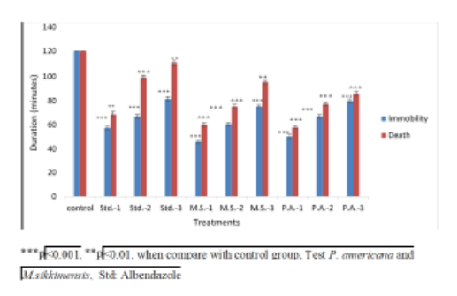


Journal of Pharmaceutical Research
Year: 2024, Volume: 23, Issue: 2, Pages: 119-123
Original Article
Nihar Ranjan Sarmah1, Preety Rani Gupta1, Raksha Sharma1, Tashi Narbu Moktan1, Ananya Bhattacharjee2,∗
1Himalayan Pharmacy Institute, Majhitar, 737136, Sikkim, India
2Associate Professor, Himalayan Pharmacy Institute, Majhitar, 737136, Sikkim, India
*Corresponding Author
Email: [email protected]
The goal was to know about the anthelmintic properties of the leaves of P. americana and peels of M. sikkimensis. An ethanolic extract from the leaves of P. americana and aqueous extract of M. sikkimensis was used to screen for phytochemicals and analyse the anthelmintic activity on Indian earthworm Pheretima posthuma to determine its therapeutic capabilities. The experiment was carried out by preparing standard drug solution (Albendazole), P. americana leaf extract and M. sikkimensis peel extract in a concentration range of 5mg/ml, 10mg/ml and 20mg/ml respectively for each. The earthworms were placed in a beaker with solutions of varying concentrations. The time of paralysis and death was noted and plotted in a graph. From the results, it was found that P. americana and M. sikkimensis extract caused paralysis in less time in a dose-dependent manner, as well as the death was caused much earlier compared to the control group. This suggests that P. americana and M. sikkimensis extract exhibited strong anthelmintic activity. Furthermore, a link has been found between anthelmintic activity and high levels of flavonoids, terpenoids and tannins. Flavonoids, tannins and terpenoids found in various extracts have been proven to have anthelmintic properties in earlier investigations. Persea americana have been reported to have alkaloids, flavonoids, glycosides, saponins, steroids, tannins, proteins, and Musa sikkimensis have been reported to have alkaloids, glycosides, saponins, steroids, terpenoids, tannins, proteins. These results lead to the conclusion that P. americana and M. sikkimensis extract may possess anthelmintic activity.
Keywords: Anthelmintic activity, Helminth, Musa, Avocado
© 2024 Published by Krupanidhi College of Pharmacy. This is an open-access article under the CC BY-NC-ND license (https://creativecommons.org/licenses/by-nc-nd/4.0/)
Subscribe now for latest articles and news.